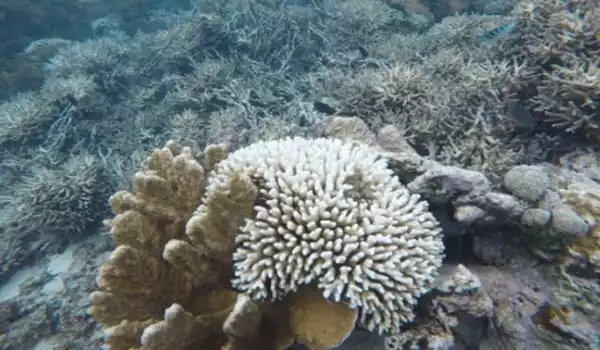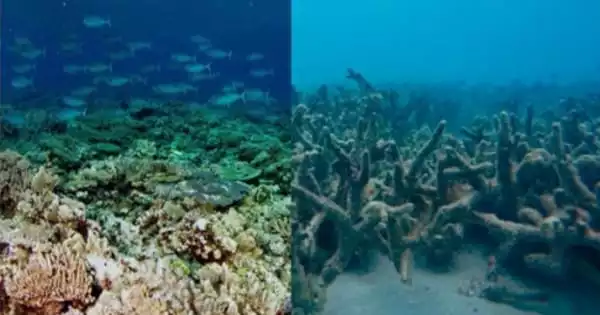Corals create skeletons as they grow by absorbing calcium carbonate from the seawater. The density of these calcium carbonate skeletons vary when water temperature, light, and nutrient circumstances change, giving summer coral skeletons a different density than winter coral skeletons.
A new study from the University of Wisconsin-Madison has implications for projecting coral reef survival and creating mitigation techniques to protect their bone skeletons from the effects of ocean acidification. Despite accounting for less than 1% of the ocean floor, coral reef ecosystems are among the most biodiverse on the planet, with over a million species thought to be associated with reefs.
The coral species that make up these reefs are known to be variably sensitive or resilient to ocean acidification, which is caused by rising carbon dioxide levels in the atmosphere. However, scientists are baffled as to why. The study found that the crystallization rate of coral skeletons varies between species and is connected to their resilience to acidity.
“Many agencies keep putting out papers saying, ‘Yes, coral reefs are imperiled,’ with no notion what to do,” says Pupa Gilbert, a physics professor at the University of Wisconsin-Madison and senior author of the study published in the Journal of the American Chemical Society. “Finding science-based solutions is a priority, and having a quantitative understanding of exactly what’s occurring with climate change to coral reefs and skeletons is critical.”
If the surface of the coral skeleton, where all of this amorphous calcium carbonate is being deposited by the living animal, crystallizes quickly, that species is immune to ocean acidification; if it crystallizes slowly, that species is vulnerable.
Professor Pupa Gilbert
Reef-forming corals are marine invertebrates that generate a hard skeleton composed primarily of the insoluble crystalline substance aragonite. Aragonite is formed when precursors comprised of a more soluble type of calcium carbonate, amorphous calcium carbonate, are deposited onto the growing skeleton and eventually crystallize.
The researchers investigated three coral taxa and examined the components of their expanding skeletons in detail. They employed a technique developed by Gilbert called PEEM spectromicroscopy, which detects the various types of calcium carbonate with the highest sensitivity to date.
When they used these spectromicroscopy images to compare the thickness of amorphous precursors to the crystalline form, they discovered that Acropora, which is more sensitive to acidification, had a much thicker band of amorphous calcium carbonate than Stylophora, which is less sensitive.

Turbinaria, a third genus with unknown sensitivity, has an even smaller amorphous precursor layer than Stylophora, implying that it should be the most resistant to ocean acidification of the three. The slower the crystallization process, the thicker the band of uncrystallized minerals.
“If the surface of the coral skeleton, where all of this amorphous calcium carbonate is being deposited by the living animal, crystallizes quickly, that species is immune to ocean acidification; if it crystallizes slowly, that species is vulnerable,” Gilbert adds. “It’s a fairly simple method for once.”
The technique may have been designed to be simple, but the data analysis required to handle and understand the PEEM images is far from easy. Each pixel of captured imaging data contains a calcium spectrum that must be evaluated, resulting in millions of data points. Data processing entails several decision points as well as tremendous computational power.
The researchers attempted to automate the analysis and apply machine-learning techniques, but neither strategy was successful. Instead, Gilbert discovered that humans are the best data processors.
Gilbert did not want to draw generalizations based on the decisions of just one or two people. So she hired a group of UW-Madison freshmen, the majority of whom were part of the Mercile J. Lee Scholars Program, which aims to attract and retain exceptional students from underrepresented backgrounds. This collection of decision makers was vast and diverse.
This group of students, dubbed the Cnidarians after the phylum to which corals, anemones, and jellyfish belong, quickly became valuable members of the team. Gilbert would assign numerous students the same dataset to analyse in parallel and discuss at their next meeting, which they did several times a week through Zoom.
“If numerous people come up with exactly the same solution while making different selections,” Gilbert says, “it implies our analysis is robust and reliable.” “The contributions of the Cnidarians were so valuable that 13 of them are co-authors on this paper.”





